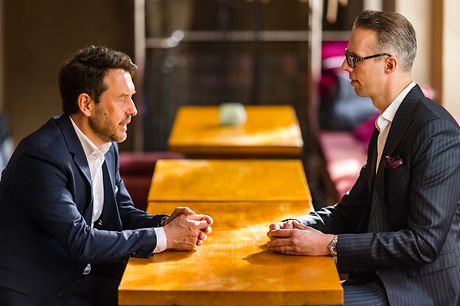Ewig: “I’ve always focused on processes in my professional career. At the Scheer Group, I managed projects in the field of logistics for Lufthansa and Deutsche Bahn. After that, I went to Porsche, where I helped to set up the business in Leipzig. During the financial crisis of 2008 and 2009, I was thinking about how I could reposition myself, and I felt it was time to do something different after so many years in the automotive industry. That’s how I got into the fashion industry. People often wonder how the two areas fit together. But it worked out quite well, since I was able to use my process-related experience and get to know a new industry. It was really exciting and dynamic. However, there was also a lack of structure sometimes, which I hadn’t expected. After a few years, I started to miss the innovative capacity and structure of the automotive sector.
In 2016, I was asked if I would consider joining Rhenus Automotive. At the time, the company had just acquired Ferrostaal Automotive, so I was able to use my experience in processes and press ahead with the integration together with my colleagues. Today, just under 10,000 employees work for Rhenus Automotive at 65 locations. We are a first-tier supplier in axle and complete vehicle assembly and are one of the key logistics providers for all vehicle manufacturers worldwide. So my path logically led me here, and it’s the process-related consistency, the innovative strength, and the strong commitment of the automotive sector to achieve this current transformation together with the OEMs that I find really motivating.”
VDE: OK, I would usually ask this question at the end, but it fits in well here. What tips do you have to offer young people? You have experienced a lot of changes. What was good, what was bad and what path would you suggest?
Ewig: “You should always think about what story you want to tell at the end of your career. You might say that you were the corporate type who started out as a consultant and ended up as the head of department. That’s one path. Another way might be to pick up an enormous amount of knowledge as you progress along your professional path, and by that I mean getting to know cultures, people and industries and satisfying your curiosity.
We are currently experiencing incredible transformation in all areas. This is partly being driven by necessity, such as the focus on CO2 neutrality and other sustainable issues. But the new technologies changing entire sectors are another driving factor. This complex situation is a good place to start exploring and to focus a little on your own interests. You shouldn’t wait for someone to tell you which path to follow, but take the approach of trial and error. We have some very good young people in the company who are doing exactly that and who go home at the end of the day with a great sense of satisfaction.”
We are seeing remanufacturing or refurbishment of batteries for e-cars
VDE: Let’s turn our attention from softer issues to more technical ones. Batteries play a significant role in your company, since you offer battery life cycle management for manufacturers of electric vehicles. What does “battery life cycle management” actually mean?
Ewig: “Our strategic roadmap included batteries for the first time in 2019. We were asked if we wanted to get involved in the battery process in terms of storage, logistics and warehousing. It was clear that the issue of batteries for electric cars would become a separate business area in the next few decades. Within the Rhenus Group, we had plenty of subsidiaries who were already looking at manufacturing and transporting batteries from a variety of angles at the time. This includes companies that develop and build certified containers for emergency batteries, or those that have been dealing with the issue of battery disposal for some time.
Ultimately, that led us to consider the various cycles of a battery so that we could map the entire process. We define the first life as the phase when we come into contact with the battery for the first time, when we make battery packs out of individual cells together with OEMs and transport them to the plants where electric vehicles are manufactured. In the Group, we also understand the importance of offering solutions further downstream in the charging infrastructure field. For example, we ran a pilot project together with Remondis for larger power chargers for certain cities.
At some point, the battery degrades to the point where it can no longer be used in a vehicle and needs a second life. There’s lots of talk about battery recycling these days, but for us that’s only one component of the second life cycle. We are taking it much further and looking at remanufacturing and refurbishing batteries. Our goal is that batteries will be sent for recycling only at the end of the process chain.”


